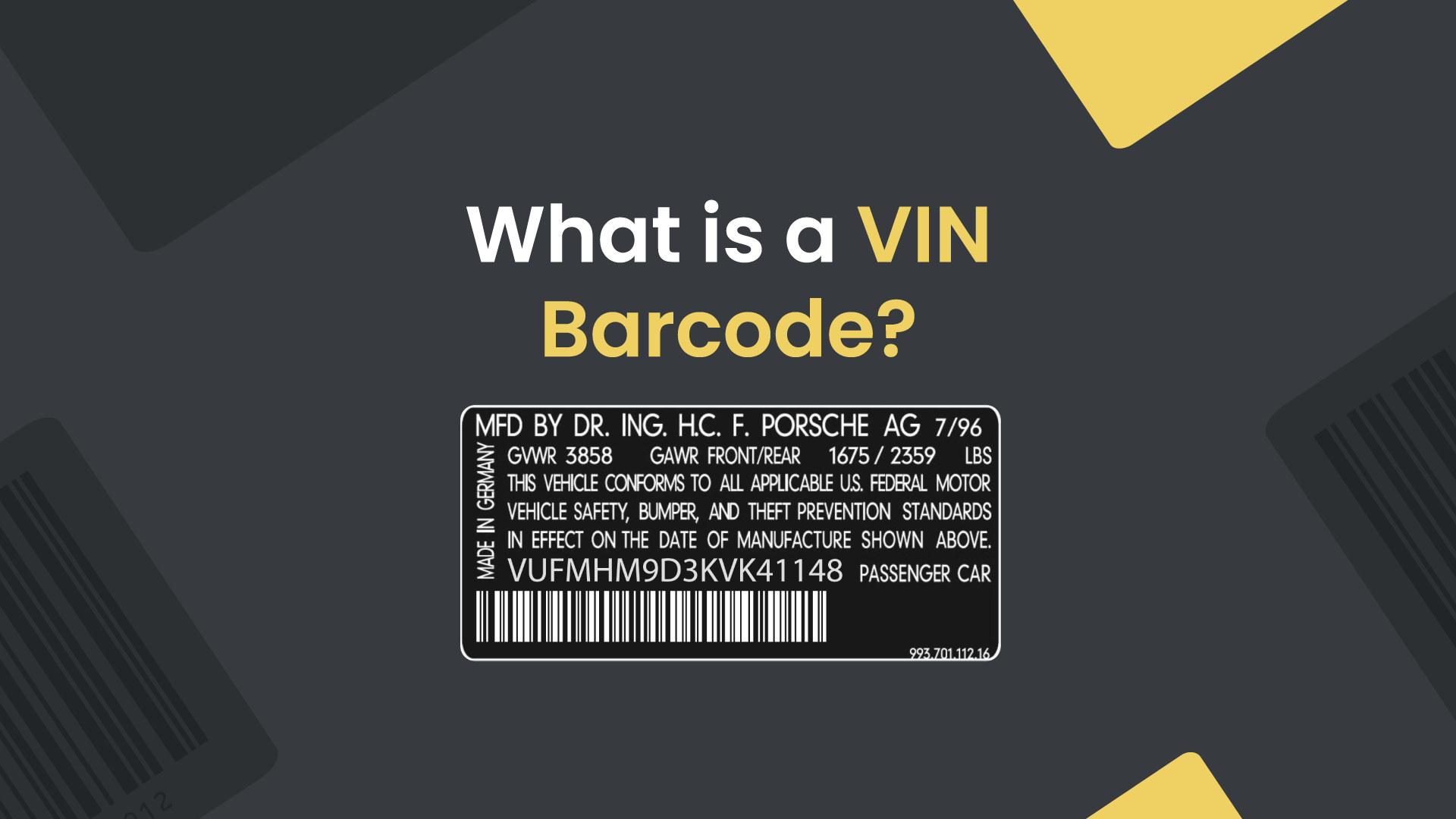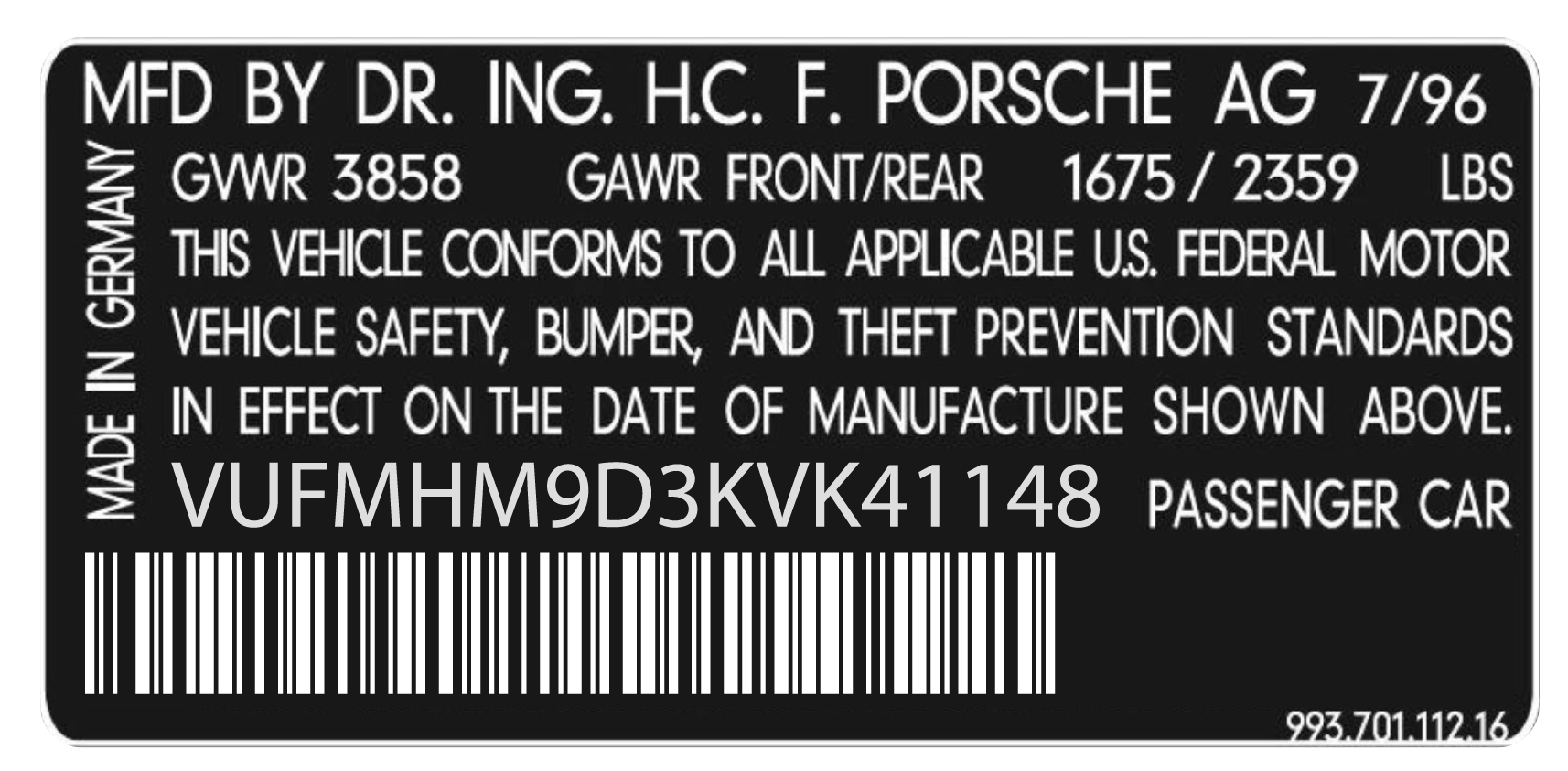
All vehicles manufactured after 1981 have a Vehicle Identification Number (VIN) barcode.
This blog will tell you all you need to know about VIN barcodes and how you can decode and track them using Orca Scan 👇
What’s a Vehicle Identification Number (VIN)?
A VIN is a unique 17-digit alphanumeric identity code assigned to a vehicle that provides vehicle-specific information. The data contained in a VIN allows us to access data like the year, country of origin, model, engine, manufacturer and more.
Think of a VIN as the DNA of a vehicle: A VIN cannot change, and each digit on a VIN unlocks a different strand of data for us to understand.
The acronym VIN stands for Vehicle Identification Number. It’s usually found on the chassis of a vehicle and followed by a one-dimensional barcode.
How can you decode a VIN?
To decode a VIN, you need the help of vehicle history records. Manufacturers control some of these records, but you can also use Orca Scan’s Vehicle Tracking Solution to decode this data.

What’s the meaning of each digit? Well, from left to right 👇
XXX-XXXXX-X-X-X-XXXXXX
The first three digits of a VIN correspond to the World Manufacturer Identifier (WMI). The first represents the country, the second is the manufacturer, and the third refers to the manufacturer’s country of origin.
XXX-XXXXX-X-X-X-XXXXXX
Digits 4 to 8 describe the vehicle, providing details such as the model (4), body (5), transmission (6), engine (7), and restraint system (8).
XXX-XXXXX-X-X-X-XXXXXX
Digit 9 is a “checker” placed to detect invalid VINs. That digit is randomly generated by assigning values in letters of the alphabet, except for the letters I, O, and Q, to ensure they don’t get misread as a number.
XXX-XXXXX-X-X-X-XXXXXX
The 10th digit identifies the model year. Vehicle models from 2010 onwards, starting with “A”, 2011 with the letter “B”, and so on. The 11th digit relates to the assembly plant where the vehicle was manufactured.
XXX-XXXXX-X-X-X-XXXXXX
Digits 12-17 are unique serial identifiers attached by each manufacturer at the point of production.
If you own or are tracking a vehicle manufactured before 1981, it is recommended to contact the manufacturer to decode your VIN.
What is a VIN barcode?
A VIN barcode is a graphical representation of a vehicle identification number (VIN) that can be scanned and processed. It is commonly used in car dealerships, repair and body shops, car auctions, and other similar industries.
Like other barcode labels in the supply chain, VIN barcodes improve the accuracy of extracting data from a VIN code by minimising the possibility of human errors. They also automate the process and gather data faster than manually analysing written VIN codes. Additionally, VIN barcodes allow easy access to data from any location, especially when using smartphones as barcode scanners.
How can you scan VIN Barcodes?
You can scan VIN barcodes using a barcode scanner app such as Orca Scan. Need step-by-step instruction? See our solution on tracking cars by VIN.

With Orca, each time you scan a VIN, you have access to all of the data and can even enter additional values such as the vehicle condition, the location and more.
What is a VIN used for?
A VIN, or vehicle identification number, contains a wealth of information and is used in various ways. Some examples of its applications include:
- Tracking vehicle production and history, including recalls and defects
- Facilitating registration and insurance processes
- Assisting in stolen vehicle recovery
- Verifying the authenticity and ownership of a vehicle
- Providing important data for automotive research and analysis.
For example… 👇
Buying a used vehicle 🚗
- Ask the car seller for the VIN to find the vehicle’s history details. Some dealerships and car-buying websites provide vehicle history reports and additional detail such as insurance claims.
- While the VIN also reveals information about previous accidents, maintenance records and past owners, you would need to check a government database to see if the vehicle has been reported as missing or is involved in other matters with the police.
- The VIN is also required for vehicle registration. So, ensuring the VIN is attached to the significant parts of the vehicle (such as engines or gearbox) can also help to locate them if they are ever stolen.
- The final portion of the VIN, digits 12-17, is commonly used for stock and inventory management purposes for car sellers.
Where can you find the VIN of a vehicle?
The usual locations where manufacturers attach a VIN are:
- On the top of the dashboard on the driver’s side.
- Inside the driver’s door.
- Near the engine block, usually on a sticker.
The VINs location will differ on motorcycles and vehicles like trailers or campers.
You can also find the VIN in the documents of your vehicle, such as the title, insurance policy, and maintenance records. All these documents contain the VIN.
How can you ensure a VIN is original?
Based on what we already know about VINs, here are a few tips that will allow us to analyse the vehicle’s authenticity with the VIN’s help.
- Always check your VIN against vehicle history records. They not only decode the VIN but ensure it is authentic 📖
- Check to see if the VIN has been removed from one or more parts of the vehicle where it is supposed to be. If any are missing, bring it up with the seller 🔍
- Check that the VIN corresponds with the license plate of the vehicle 🚗
- Incomplete VINs or incorrect digits on legal documents are also red flags ❌
Who can issue a VIN?
Industrial manufacturers are generally in charge of managing the allocation of VINs. VINs are issued to the vehicle on the production line and remain on the vehicle forever.
In rare cases, a VIN can be legally destroyed or reassigned to another vehicle.
What happens if you are an individual manufacturer? Do homemade vehicles, like trailers or pop-up campers, need a VIN?
Not all homemade vehicles are required to have a VIN, but the fact that they are homemade does not make them exempt. It is the weight of your vehicle that decides.
Also, there’s no specified location where you place the VIN on a homemade trailer, making VINs challenging to find. The process to obtain a VIN for a homemade vehicle may vary in each country, but to apply at your local VIN issuance office, you need to be sure of the following:
- Know the weight and height of your vehicle.
- Have a register of the materials used to build it.
- Be sure your vehicle has been inspected and has a valid certificate to be driven on the road.
- Have proof that you have insured the vehicle.
Questions?
If you have more questions about scanning VIN barcodes or any other barcode. Get in touch, and we’d be happy to help!
